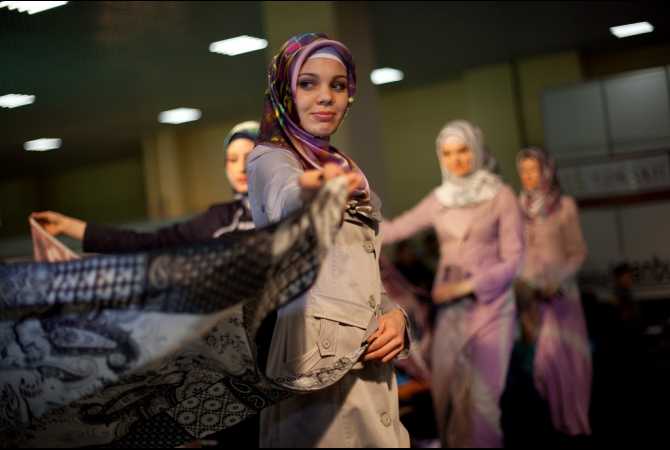Designers capitalize on growing market for Islamic fashion in Turkey.
Jodi Hilton

ISTANBUL, Turkey — When styling hijabs became all the rage among Islamic women in Turkey a while back, Zehra Kamacioglu, a hairdresser, began crimping and sculpting bridal headscarves into cascades of flowers.
Then she got the idea to make ready-made sculpted hijabs so that a woman getting married or attending a special event could skip the salon altogether.
In 1995, Kamacioglu founded Zehrace and in this year’s Islamic Fashion Expo, she showed fuchsia mod caps with built in hijabs, and hood-shaped sport hijabs, in addition to her evening wear.
“Islamic women want to wear different things and want more fashionable things,” Zehrace’s export manager, Gamze Ozturk, said. “Especially young Islamic women.”
Turkish garment producers, who for years have dominated mainstream production for Europe in jeans and t-shirts, are finding a large, new market in the modestly dressed Muslim woman.
At the Islamic Fashion Expo, now in its third year, vendors showcased elegant and finely manufactured clothing, including flowing black kaftans accented with an inverted purple “V” by Beyzanur, colorful 100 percent Chinese 10-color designed silk scarves by Sarar, and Islamic swim and sportswear by Hasema.
“We looked around the world, and around Turkey and there is no exhibit like this,” said Onur Goksel, the exhibition’s project director.
As a deejay spun dance music, disco lights illuminated the catwalk around which families gathered. Children played with red balloons while their mothers, many wearing headscarves, sat on school desk-chairs. Men wearing suits set up video cameras on the far end. The emcee, wearing a silver suit and pointed shoes entertained with jokes while the crowd waited.
Finally, leggy Bosnian and Russian girls from the Star Model agency wearing trench coats and headscarves strode out on five-inch heels. Pouted augmented lips and thrusting their hips at jaunty angles they modeled incongruously moderate Muslim swimwear, kaftans and hijabs.
Bosnian model Tamara Cvijanovic, 21, on a month-long modeling tour in Turkey, said that during the previous week in Istanbul she modeled transparent bathing suits and skimpy underwear.
Modeling Islamic clothes, she said, “is so strange for us and all the girls because we don’t wear those clothes at home.”
Turan Kisa, export manager for Hasema, said 20 years ago the company was the first in Turkey to produce covered swimwear acceptable for Islamic women.
“The first models were not so fashionable,” she said. “Now we are producing really fashionable design.”
The swimsuit is shaped like a wetsuit, with a built in hood, over which a woman wears a sort of zip-up windbreaker to mask her shape. One navy blue model is embroidered with nautical motifs.
Sports-models made of lycra matching pieces cover the arms, legs and head in a pajama-like shape. More skimpy short sleeve models with thigh-length pants are geared toward women who exercise in female-only pools. Bright pinks and blues are popular with girls while middle-aged women tend to go with classic colors like browns and black, Kisa said. Hasema also produces knee-length bathing suits for Muslim men.
At a nearby booth, Yesmin Yedil modeled plus-sized topcoats to a potential buyer. Yedil and her colleague Hukase Arslan design clothing for Professional Tasarim. Single and double-breasted trench coats in beige, navy and lavender are accented by contrasting color trim and ribbon.
“For the new trend we use new colors,” she said. “The special thing [is] the accessories on the clothes.”
Still, Yedil said, “everything goes on the classic system.”
Filiz Yetim, dressed in a fitted black blouse and loosely tied, burgundy headscarf, produces custom-made wedding and special-event dresses.
Her lacy party dresses draw inspiration from the Ottomans and French. Offering rose-flavored Turkish delight and a spritz of lavender, she said her designs (under the mark Hayalen, which means, “dreaming” in Turkish) are for open-minded people.
“I would like to make something special for them,” she said.
Source: globalpost
